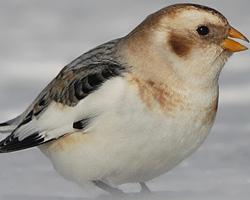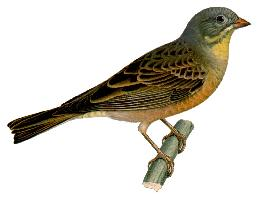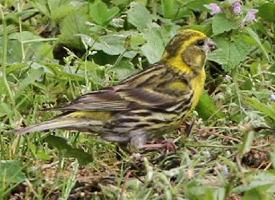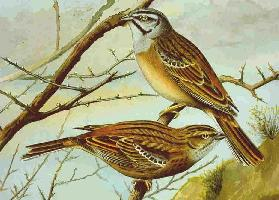
Starea de conservare
| Neînfricat |
Descrierea animalului
The Snow Bunting (Plectrophenax nivalis) is a captivating bird species that belongs to the family Calcariidae, which encompasses longspurs and snow buntings. This small, sparrow-sized bird is renowned for its remarkable adaptability to cold climates and its striking plumage, which varies significantly between seasons. The snow bunting is a migratory bird, breeding in the high Arctic and wintering further south in temperate zones across Europe, Asia, and North America.One of the most distinguishing features of the snow bunting during the breeding season is its plumage. Males exhibit a predominantly white coloration with contrasting black back, wings, and tail. This dramatic black-and-white appearance is complemented by a touch of rust color on the wing feathers in some individuals. Females and non-breeding males have a more subdued coloration, featuring a mix of brown, black, and white, which provides excellent camouflage against the tundra landscape and rocky habitats they frequent.
Snow buntings are ground-nesting birds, showing a strong preference for open landscapes devoid of dense vegetation, such as the Arctic tundra, where they can take advantage of the brief Arctic summer. Their nests are meticulously constructed in crevices or under rocks, safeguarded from predators and the harsh Arctic elements. The female lays a clutch of 3-7 eggs, which she incubates for about two weeks. Both parents partake in feeding the nestlings, which fledge approximately two weeks after hatching.
In terms of diet, snow buntings are omnivorous, with a diet that varies seasonally. During the breeding season, they primarily feed on insects and spiders, providing a high-protein diet to their growing chicks. In the winter months, their diet shifts to seeds and small grains, which they forage from the ground, often in flocks. These flocks can sometimes be seen swirling through the air in tight formations before descending to feed, a behavior that adds to their allure.
The migratory patterns of the snow bunting are a testament to its hardiness. As winter approaches, snow buntings migrate southwards from their Arctic breeding grounds to escape the extreme cold and scarcity of food. However, they still inhabit relatively cold regions during the winter, including parts of the northern United States and temperate zones of Eurasia. Come spring, they undertake the long journey back to their breeding territories in the Arctic, a feat that highlights their remarkable endurance and adaptability.
The snow bunting's song is a sweet, melodic trill that is often likened to the tinkling of glass. This song, along with their striking appearance and fascinating behaviors, makes them a favorite among birdwatchers and nature enthusiasts. Despite the challenges posed by their harsh habitats, snow buntings have managed to thrive, although climate change poses a new threat to their Arctic breeding grounds.
Conservation efforts for the snow bunting are focused on monitoring their population trends and protecting their habitats from the impacts of climate change. While currently not considered endangered, the snow bunting serves as an important indicator species for the health of Arctic ecosystems, reminding us of the fragility of these remote landscapes and the urgent need to protect them.
In summary, the snow bunting is a remarkable bird that embodies the beauty and resilience of the natural world. Its ability to thrive in some of the planet's most extreme environments, coupled with its striking seasonal plumage and melodious song, makes it a symbol of the wild and untamed landscapes it inhabits.
Animale similare
Fotografii noi cu animale
Top 10 animale
- Dolphin gull (Leucophaeus scoresbii)
- Diana monkey (Cercopithecus diana)
- Moustached guenon (Cercopithecus cephus)
- Galápagos tortoise (Geochelone nigra complex)
- Stone loach (Barbatula barbatula)
- Japanese macaque (Macaca fuscata)
- Greek tortoise (Testudo graeca)
- Russian tortoise (Testudo horsfieldii)
- Common flying dragon (Draco volans)
- Galápagos penguin (Spheniscus mendiculus)


